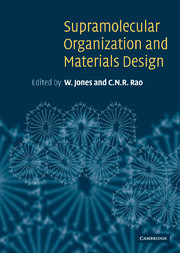Book contents
- Frontmatter
- Contents
- List of contributors
- Preface
- 1 Assembly and mineralization processes in biomineralization: strategies for forming biological composite materials
- 2 Mesoscale materials synthesis and beyond
- 3 Towards the rational design of zeolite frameworks
- 4 Mesoscale self-assembly: the assembly of micron-and millimeter-sized objects using capillary forces
- 5 Design of amphiphiles for the modulation of catalytic, membranous and gelation properties
- 6 Nanofabrication by the surface sol-gel process and molecular imprinting
- 7 The hierarchy of open-framework structures in metal phosphates and oxalates
- 8 Mesoscale self-assembly of metal nanocrystals into ordered arrays and giant clusters
- 9 Layered double hydroxides as templates for the formation of supramolecular structures
- 10 Molecular machines
- 11 Some aspects of supramolecular design of organic materials
- 12 Controlling crystal architecure in molecular solids: the supramolecular approach
- Index
12 - Controlling crystal architecure in molecular solids: the supramolecular approach
Published online by Cambridge University Press: 18 December 2009
- Frontmatter
- Contents
- List of contributors
- Preface
- 1 Assembly and mineralization processes in biomineralization: strategies for forming biological composite materials
- 2 Mesoscale materials synthesis and beyond
- 3 Towards the rational design of zeolite frameworks
- 4 Mesoscale self-assembly: the assembly of micron-and millimeter-sized objects using capillary forces
- 5 Design of amphiphiles for the modulation of catalytic, membranous and gelation properties
- 6 Nanofabrication by the surface sol-gel process and molecular imprinting
- 7 The hierarchy of open-framework structures in metal phosphates and oxalates
- 8 Mesoscale self-assembly of metal nanocrystals into ordered arrays and giant clusters
- 9 Layered double hydroxides as templates for the formation of supramolecular structures
- 10 Molecular machines
- 11 Some aspects of supramolecular design of organic materials
- 12 Controlling crystal architecure in molecular solids: the supramolecular approach
- Index
Summary
Introduction
The properties of molecular solids are well known to depend not only on the structure of the molecule itself, but also on the three-dimensional architecture adopted during crystallization. Such is the variation in properties with crystal structure that the existence of different polymorphs can, for example, switch on and off photoinduced reactions as well as profoundly affect the pharmaceutical activity of drugs [1–3].
The structure adopted by a molecule in the crystalline state is determined by a complex balance of forces, each possessing varying degrees of strength, distance dependence and directionality. The ability to control these forces to create predetermined three-dimensional architectures is a formidable problem. Given the current situation regarding the possible ab initio prediction of crystal structures (even for simple high-symmetry systems), it is unlikely that a rigorous and effective methodology for structure prediction will soon emerge [4]. The solid-state chemist, therefore, approaches the problem by attempting to identify particular interactions within a crystal which occur regularly and which seem to play a significant and repetitive role in directing molecules during crystallization. This approach has been compared with the synthon approach in classical organic chemistry in which the target is a complex molecule – the synthon approach identifies structural units which can be linked by known synthetic methods to give the desired molecule [5]. In designing a molecular solid, the equivalent position is to identify robust, predictable intermolecular interactions which can be used to create supermolecules [6, 7].
- Type
- Chapter
- Information
- Supramolecular Organization and Materials Design , pp. 391 - 443Publisher: Cambridge University PressPrint publication year: 2001
- 4
- Cited by

